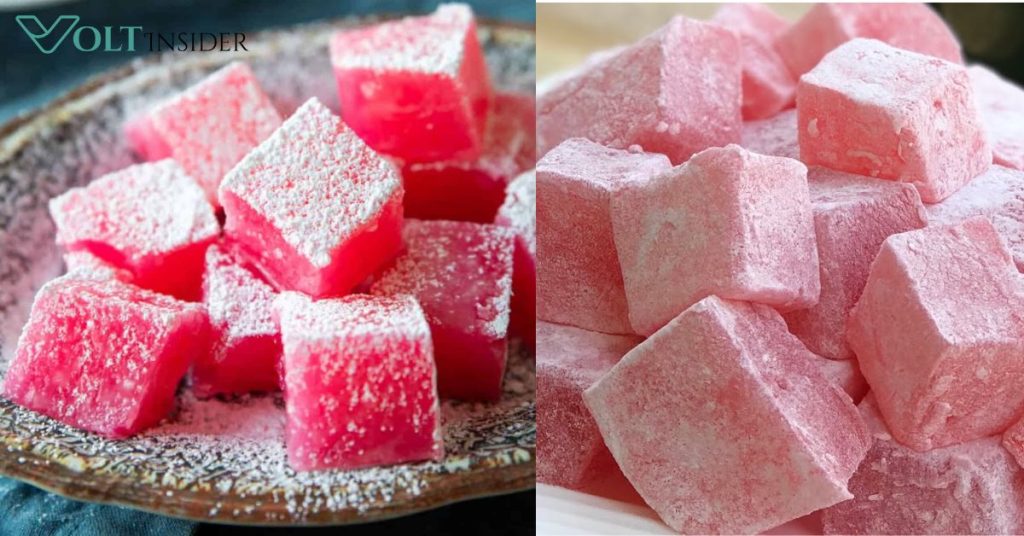Introduction: The Allure of Turkish Delight
Turkish Delight, known as lokum in its homeland, is more than just a sweet treat—it’s a symbol of cultural heritage, tradition, and timeless flavor. With its soft, chewy texture and a variety of delightful flavors, Turkish Delight has charmed sweet lovers around the world for centuries. From family gatherings in Istanbul to gift boxes in London, this iconic dessert has a story to tell.
Made traditionally from sugar, starch, and water, Turkish Delight is infused with regional flavors like rosewater, lemon, and mastic, and often filled with pistachios or hazelnuts. It’s a dessert that brings together generations, often shared over conversations and cups of strong Turkish tea or coffee. Today, it continues to win hearts both for its taste and the stories it carries.
A Glimpse into the History of Turkish Delight
Turkish Delight, or lokum (from the Ottoman Turkish raḥat al‑ḥulqūm, meaning “comfort of the throat”), traces its roots back to the kitchens of both the Anatolian Seljuk Empire and the Ottoman Empire. As early as the 15th century, confectioners blended honey or grape molasses (pekmez) with flour to create soft sweets that soothed the palate .
Yet the modern form of Turkish Delight—a gel-like treat based on sugar and starch—became widely known in 1777, when Hacı Bekir, a confectioner from Kastamonu, opened his shop in Istanbul’s Bahçekapı district. He’s often credited with refining the lokum recipe using cornstarch and sugar, earning his place as the chief confectioner to the Ottoman court. While some debate the true inventor of lokum (similar sweets existed earlier in Persia and the Arab world), Bekir’s shop popularized the sweet and helped standardize its preparation.
By the 19th century, Turkish Delight had crossed borders and captivated the West. British travelers encountered lokum, bringing it home and giving birth to the term “Turkish Delight”. In literature, Charles Dickens referred to “Lumps of Delight” in The Mystery of Edwin Drood, and C.S. Lewis later featured it in The Lion, the Witch and the Wardrobe, cementing its place in Western popular culture.
What Makes Turkish Delight Unique?
The Exceptional Texture & Ingredients
The hallmark of Turkish Delight lies in its enchanting gel‑like, chewy texture, which is achieved through a careful balance of starch and sugar. Traditional recipes call for a slow-cooked sugar syrup heated to the “hard ball” stage (~260 °F/127 °C), then combined with a thick starch slurry—typically cornstarch or wheat starch—and simmered until it transforms into a translucent, elastic gel. This extensive stirring process, often lasting several hours, is essential: it’s this laborious cooking that gives Turkish Delight its uniquely satisfying bite and silky mouthfeel .
Beyond the starch-sugar base, the magic of Turkish Delight comes from its aromatic flavorings. The most classic is rosewater, offering a delicate floral note, but other beloved variations include lemon, mastic, bergamot, cinnamon, mint, and orange blossom, sometimes with a hint of cream of tartar or citric acid to help prevent sugar crystallization and smoothen texture.
Enhancements & Flavor Variety
What further distinguishes Turkish Delight is its flavor diversity and adaptability. Many variants feature chopped nuts—like pistachios, walnuts, or hazelnuts—either suspended throughout the gel or pressed atop the cubes, adding crunch and richness. Some regional specialties, such as those from Afyon, layer in kaymak (clotted cream), while modern takes may coat cubes in powdered sugar, copra, or coconut to prevent sticking and enhance visual appeal.
Another unique feature is the candy’s colorful presentation: Turkish Delight often dazzles with pastel hues—pink, amber, green, or peach—which correspond to flavors or patterns. Despite such visual flair, the core principles remain: natural flavor infusion, minimal colorings, and the signature soft yet chewy texture that melts in your mouth—a sensory delight that has endured through centuries .
Cultural Significance and Global Appeal
A Symbol of Hospitality & Celebration
In Turkish culture and across the broader Middle East and Mediterranean region, Turkish Delight (lokum) is deeply woven into rituals of generosity and warmth. It’s traditionally offered to guests alongside Turkish coffee or tea, symbolizing hospitality, respect, and goodwill.
This sweet treat appears notably during festivals and family milestones—from Ramadan and Eid celebrations to Weddings and engagements—where its sharing signifies blessings and joy. Local traditions even see Turkish Delight as a metaphor for life’s sweetness, with the belief that offering it brings sincerity and shared happiness.
From Ottoman Palaces to Global Treat Aisles
Originating in the kitchens of Ottoman sultans, Turkish Delight quickly transcended empire walls. Its transformation under confectioner Hacı Bekir in the late 1700s led to acclaim within the royal court. Over time, lokum migrated west—adopted by Europe and beyond—often found in elegant boxes as souvenirs or gourmet treats.
Its global reach is reinforced through literature and film—most famously in C.S. Lewis’s The Lion, the Witch and the Wardrobe, where it’s depicted as an enchanting, even tempting, confection.
A Driving Force in Modern Candy Trends
In recent years, Turkish Delight has emerged as a key player in the global trend toward artisanal and culturally‑inspired candies. Its natural flavor base—using essentials like rosewater, citrus, nuts, and mastic—aligns with growing consumer demand for clean labels and authentic nutrition. Furthermore, its production techniques and flavor variations continue inspiring the candy industry, driving innovation in textures and premium packaging rooted in heritage.
How to Enjoy and Store Turkish Delight
Enjoyment Tips and Serving Ideas
When indulging in Turkish Delight, the key is to savor each piece slowly to appreciate its delicate flavors. Traditionally, it is served after a meal alongside Turkish coffee or tea—the sweetness perfectly complements the bold bitterness of the brew. Many connoisseurs recommend sampling one cube at a time, allowing its soft gel to gently dissolve in your mouth, releasing layers of flavor from rosewater to pistachio.
For a more elaborate tasting experience, you can pair multiple flavors—like pistachio, lemon, and mint—on a decorative tray, enhancing both visual appeal and taste variety . Adding a small glass of water is customary to cleanse the palate between flavors and coffee sips, letting each sweet note shine.
Storing Turkish Delight for Freshness
Turkish Delight is surprisingly delicate, and its quality is greatly influenced by storage methods:
- Choose a cool, dry spot. Avoid heat, direct sunlight, and humidity, which can cause pieces to sweat or become sticky.
- Allow it to dry. If homemade, let the cubes sit 24 hours before dusting, preventing premature sweating after storing.
- Use proper containers. Stack pieces in a glass or metal airtight container, layering with parchment or wax paper to avoid clumping.
- Avoid refrigeration. Chill exposure causes condensation, leading to moisture buildup and sticky texture . However, in extreme heat, refrigeration—sealed and brought to room temp before serving—can be acceptable.
Source: Eskapas / Sirkecimansion
Shelf Life: From Fresh to Fortified
- Homemade delights are best consumed within 1 week, though they can last up to 2 weeks if stored correctly.
- Commercially packaged lokum, often with preservatives, can stay fresh for 1–3 months when kept in ideal conditions.
- Some producers note that refrigeration (sealed) may extend shelf life to 3 months, and even freezing can preserve Turkish Delight for up to a year, though thawing must be gradual.
Summary Table: Storage Essentials
| Condition | Recommendation |
|---|---|
| Temperature | Cool & stable, avoid heat and humidity |
| Container | Airtight glass or metal, not plastic if homemade |
| Layering | Use parchment or wax paper between layers to prevent sticking |
| Dusting | 24‑h air drying for homemade, then dust generously with starch/sugar blend |
| Refrigeration | Not recommended, unless climate is very hot. If used, seal tightly, thaw before serving |
| Shelf Life | Homemade: 1–2 weeks |
Conclusion
Turkish Delight stands as a timeless symbol of culinary craftsmanship, weaving together centuries of history, tradition, and sensory delight. Its unique gel-like texture, flavored with delicate rosewater, citrus, or nuts, speaks to a rich tradition of confectionery innovation originating in the Ottoman era . From the iconic Hacı Bekir shop in Istanbul to modern artisanal producers worldwide, Turkish Delight continues to enchant with its blend of hospitality, cultural significance, and flavorful craftsmanship.
Enjoying Turkish Delight is best done slowly—one cube at a time, often alongside Turkish coffee or tea. Proper storage—cool, dry conditions with airtight packaging—is essential to maintain its texture and taste. While homemade versions stay fresh for around a week, packaged ones can keep for months under the right conditions; even freezer storage may extend shelf life up to a year.
Frequently Asked Questions (FAQs)
- Is Turkish Delight vegan and gluten-free?
- Yes, traditional Turkish Delight is typically vegan and gluten-free, made from sugar, water, and starch—though some commercial versions may include gelatin or gluten-containing additives, so checking labels is advised.
- Can I refrigerate or freeze Turkish Delight?
- Refrigeration is generally discouraged due to condensation, which may negatively affect texture . However, in very warm climates, refrigeration in an airtight container can be acceptable. Freezing is possible—sealed Turkish Delight can stay fresh for up to a year, but should be thawed gradually.
- What is the best way to enjoy Turkish Delight?
- Savor it slowly, one cube at a time, ideally with Turkish coffee or tea. Offering a small glass of water between pieces helps cleanse the palate, allowing you to fully appreciate each flavor—from rose and lemon to pistachio and mint.
- Are there any common allergens in Turkish Delight?
- While traditional Turkish Delight is typically free from common allergens, many varieties include nuts like pistachios or walnuts, so those with nut allergies should check ingredient labels carefully before consuming.






